It’s hard to believe that it has been over two years since the new, benchmark-setting S-class went on sale in India. It doesn’t feel that long ago because of just how impressive and modern the big Merc was and continues to be, despite its decidedly old-school luxury appeal. However, when we put it up against the rest of the class – the A8, 7-series and XJ – it was surprising to see that the Merc’s victory wasn’t as dominant as it traditionally has been in the past. The A8 and XJ put up a good fight, and even the BMW, the oldest of the bunch, managed to hold its own quite well.
Well, the oldest is now the newest, as BMW India has just introduced the all-new ‘G12’ 7-series, which we’ve already been bowled over by. As can be expected from a company as big as BMW, they haven’t held back with their new flagship limousine. Every one of the old car’s shortcomings has been picked at with a pair of tweezers and every strength of the S-class has been targeted with a sort of vengeance that could only come from a century-old rivalry. As ever, it’s great to drive, but this time, it’s got genuinely impressive luxury chops too and enough tech to embarrass the Starship Enterprise. This might just be the one that breaks the new S.
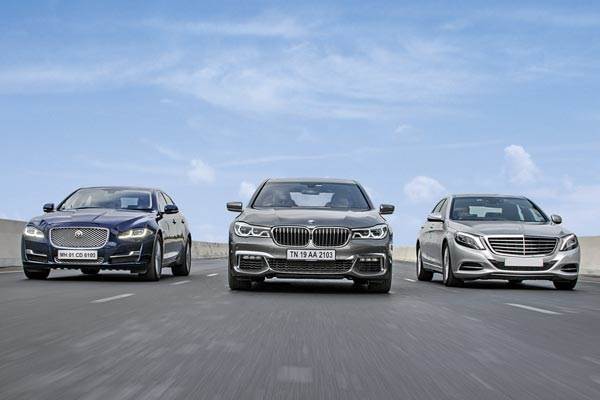
But wait, there’s a third way – because Jaguar also has a new XJ. Granted, it’s just a facelift, but it gets JLR’s latest tech on the inside, some classy new detailing on the outside, and diesel V6 with a ridiculous 300hp and 700Nm! Moreover, what we loved about the XJ before hasn’t changed – it is still a uniquely British proposition, oozing with charm like no other. So which will it be – the new tech-fest, the current favourite or James Bond?
Extended Cuts
All these cars can be had in ‘standard’ form elsewhere in the world, but in chauffeur-driven India, they’re all LWB or long-wheelbase versions. This makes all of them look visibly stretched and that’s a good thing when you want to arrive in style. The new 7-series in particular looks properly limousine-like. Just imagine the valet swinging open that huge rear door and you stepping out like the boss you are. There are some details on the 7 that not everyone agrees with though – some find the grille too large and don’t like the way it meets the headlamps, others find the rear too ordinary, and not everyone’s a fan of the M Sport pack on this car. Still, most agree that it has immense presence, with a lot of chrome and bling that announces its arrival with a megaphone.
The S-class is quite the opposite. Sure, it too has a humungous chrome grille but everything else is very restrained and regal. Even the leaf-shaped adaptive LED headlamps are smooth and elegant as they bend up into the flanks. The shape of the car is smooth and the distinct three-box shape gives it that classic luxury sedan look. Strangely, the only qualm with the S-class’ look is a result of the cars that came after it – the new C-class and the upcoming E-class mimic the S so closely, that it just doesn’t look as special as when we first saw it.
And then there’s the Jaguar. Despite not being the winner, it would still be the favourite of many because of how it tugs at your heartstrings, and the looks are a huge part of that. What a shape! How does something so sleek and low even work as a luxury limousine? It’s been given a facelift, and all that’s changed are headlamps, tail-lamps and bumpers – but what a difference it’s made. The new ‘J-blade’ LED signature lights are just so menacing and, combined with that aggressive nose, it clearly looks the sportiest of the lot. Sorry BMW.
Board Rooms
The S-class and the XJ are unchanged on the inside from the last time you saw them, so I’ll keep it brief. The wide, swooping dashboard of the Mercedes is equal parts classic and modern – four chromed rotary AC vents on one hand and a pair of 10-inch screens on the other. The quality of materials is pretty much flawless, and all the tech is buried deep under layers and layers of luxury. Merc’s Comand system still isn’t the most intuitive and clearly feels a generation behind now, but it is fully featured and the screen looks great.
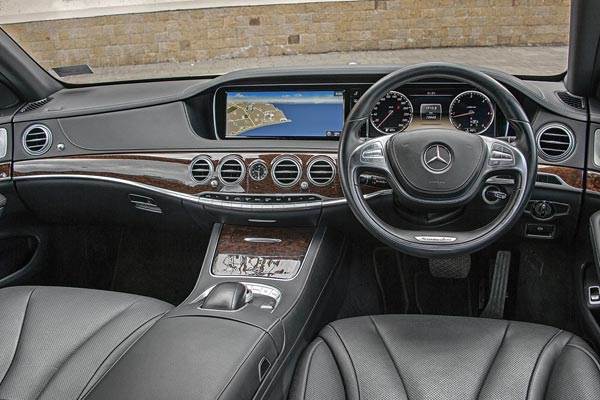
The Jaguar’s dash is quite flamboyant, what with its bulging AC vents, complex layers and ‘Riva Loop’ of continuous wood trim on the dash. There are thick slabs of veneer on the doors as well and, just like the exterior, there’s something so un-German about the cabin. That also applies to the materials and build, which, although improved with the facelift, is still some way behind the other two cars. The digital instrument cluster is new this time, as is the touchscreen – which uses JLR’s latest InControl Touch Pro system. Though its quite an effort to dig deep into all the functions it comes with, the fluidity with which this feature-packed infotainment system works, is really impressive. This makes it all the more disappointing that Jag didn’t spring for the larger screen for its flagship sedan.
The new 7-series dash is a quantum leap from the previous car, and purely in terms of fit and finish, it’s more than a match for the S-class. It too gets generous smatterings of real metal, thick and rich wood grain, metallic switchgear and soft leather. The design, however, is still a bit too functional looking, and doesn’t have the same visual impact as the Jag’s or the Merc’s. It does, at least, look very techie, and that’s because it is. There’s a digital display for everything; even the AC and seat-heater controls are tiny touchscreens in themselves, which actually makes them quite tricky to use on the move. Still, there’s no arguing that the new 7-series is at the top of this technological hill. You’d have to read our road test of the 730Ld to get the full lowdown, but the new i-Drive is easily the best system around. It’s slicker than ever, and apart from the usual controls, it now has a touchscreen and hand-gesture controls too. The latter, however, offers limited functionality and doesn’t work very well; it’s clearly a technology in its infancy and should be better by the next update.
Game Of Thrones
Seats: an essential but uninteresting thing in most cars, but one of the most crucial elements of these three. In these cars, certain things are considered essential. Electric adjustment and recline for all four seats, massage facilities at the rear, electric rear window and windscreen sun blinds, dual sunroofs, rear-entertainment screens, four-zone auto climate control and, because this is India, a rear centre armrest that folds away in case you want to bring a fifth passenger along. Another thing you can be sure of is that there is ample room in the back seat of any of these stretched sedans; only the XJ has marginally less headroom than the other two, owing to that sloping roof.
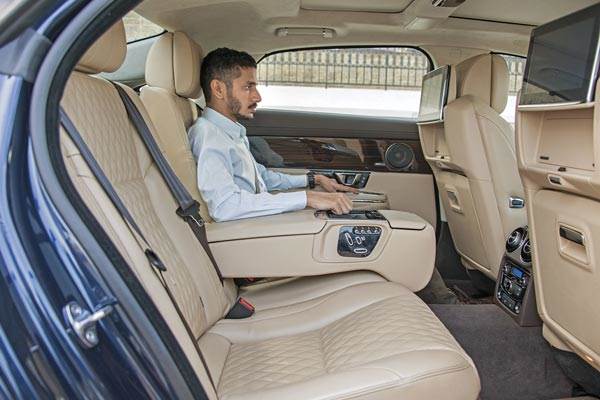
The Jaguar also feels like it has the most substantial cushioning. You feel like you’re sitting ‘on’ the seats rather than ‘in’ them, and that gives a throne-like feeling that’s supremely comfortable, if perhaps not quite as supportive as the other two. The quilted leather is rich and soft by any standard and feels nice like an old British pub armchair. What is a bit irksome is the way the XJ’s rear seat controls are split between the doors, centre armrest and the AC console; they should have all been in one place. You can, rather counter-intuitively, adjust all of this from the touchscreen at the front.
The BMW offers the widest array of adjustment for the rear seats and you can truly find a position to suit even the weirdest of frames. Once you’re there, un-dock the Samsung tablet from the armrest and fiddle around with everything from the seats, to the blinds, to the entertainment, to the climate control. I particularly like the fact that the backrest has a hinge in the middle, so you can get better shoulder support without losing your angle of recline. Speaking of the angle though, it does feel a bit odd, as reclining the seat pushes you outwards, rather than letting you sink further back; best not to recline it all the way.

Overall though, it’s the S-class that has the best back seats. The chairs are just perfectly contoured, and while they don’t offer the same array of adjustment as the 7-series or the cushioning as plush as the XJ, they are simply the most comfortable and supportive. The way they recline is just about perfect, and though all three let you move the front passenger seat forward from the rear, the Merc is the only one that gets you a fold-out foot rest as well. For the diesel car, Mercedes has also been clever to delete features that matter to the chauffeur – night vision, front-seat memory, front-seat massage and 360-degree cameras – and kept everything you’ll want in the back seat. BMW, meanwhile, has given the front seats heaters, but not the rear, but everything else is catered to the back. In the Jag, all four seats are heated, cooled and offer massaging, so everyone wins.
Air Max
Yes, all four cars have air springs suspending all four wheels, and while that might sound the norm in this class of expensive limousines, until recently, that wasn’t the case. The previous 7-series had air suspension only at the rear, and though it handled well on the limit, it didn’t have great ride quality. Not only does the new 7 have air springs at the front, the whole system has been superbly calibrated and is incredibly quick to react. As a result, the 730Ld finally has a ride befitting its price and position. Stay away from Comfort+ mode, however, as the car floats too much over even the slightest undulation. The standard Comfort mode doesn’t move you around as much and is still pillow soft. Move it over to Sport or Sport+ and all of a sudden, body roll and float are almost entirely eliminated, and it’s still more comfortable than most ‘mortal’ cars. There is one thing, a bit of pitter-patter you’ll feel over undulations, but that could just be down to the M Sport’s 19-inch wheels; the standard Design Pure Excellence version gets 18-inch wheels and 50-profile tyres. The truth, however, is that the 7-series just doesn’t completely settle down in any mode and there’s always a hint of nervous body movement on a less-than-smooth surface.
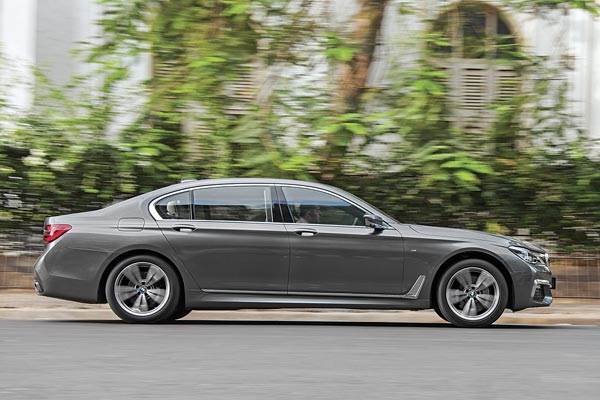
The Jaguar, meanwhile, has downsized from 19-inch wheels to 18-inchers for a taller 50 and 45-profile tyres (front and rear), and aesthetically speaking, that’s a change we’re not happy about. More to the point, the XJ always rode really well, despite those wheels, so the move seems a bit unnecessary. You don’t get five drive modes like the 7-series – just two – Comfort and Sport, and there doesn’t seem to be too much of a difference in the ride between the modes, frankly. It’s a good compromise between comfort and body control, but it rolls around a little too much compared to the 7-series in Sport mode. The other change to the Jag is a move from hydraulic to electric power steering, but if we didn’t tell you, you probably wouldn’t guess. There’s so much delightful feedback and yet it’s light enough – it makes the XJ a joy to drive even at low speeds, which is great, considering how often any of these ever visits a track. Still, overall, you’d probably be better off in the new 7-series going quickly up a ghat road. The Jaguar might make a better emotional connection, but with its feelsome steering and brilliantly judged suspension, it’s the 730Ld that’s the more competent around bends.
The antithesis of a track car is the Mercedes-Benz S-class. Unlike the other two, it makes no pretensions of sportiness, and why should it? It’s a limousine. The steering is not razor sharp but it’s fluid and quite direct; the very relaxing road manners mean you’d never even want to try driving this car in anger. There is a Sport button, but all that really does keep the body movement in check; in fact it’s the more comfortable mode on most Indian roads. This is the best riding car in this test, and although the BMW now comes closer than ever, that last degree of finesse belongs to the Merc.
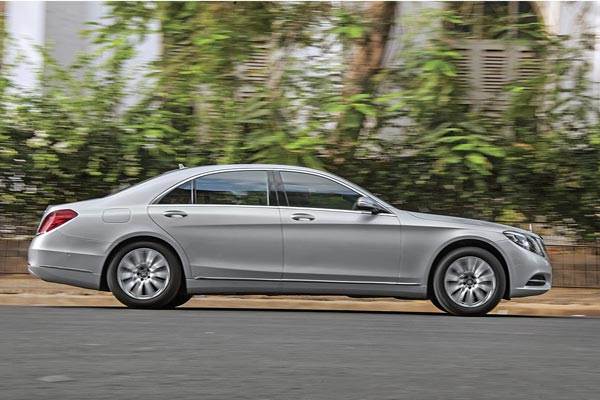
Velvet Revolvers
As with the handling, the S 350d’s engine too is not designed to be quick or sporty. It’s silken smooth, very linear and progressive and so very refined. You just don’t feel like pushing it. In fact, refinement overall is best in the S-class, though once again, the BMW comes really, really close. Although the S-class’ 2,987cc V6 diesel’s 620Nm torque output is the same as the 730Ld’s, with the highest kerb weight and lowest power output, it’s no surprise that the big Merc is the slowest car here, taking almost eight seconds to hit 100kph. It’s not helped by the leisurely seven-speed gearbox that’s good at slipping silently between ratios, but not so good at snapping to attention when you want a quick downshift. But again, urgency is just not this car’s thing.
It certainly is the XJ’s thing. At 300hp and 700Nm, the Jag’s 3.0-litre diesel V6 is far more powerful and torquey than the ones in the other cars. It’s a revised version of the twin-turbo unit in the previous car, but with the added power has come more noise, but not in a bad way. Though not as refined as the others, the Jag’s V6 diesel has a nice soulful growl to it. Mash your foot down and there’s a bit of a pause before the eight-speed gearbox kicks down but after that you better be alert. The big cat just leaps forward frantically. In fact, so sudden is the power delivery that it’s tricky to drive this car smoothly even at slow speeds. When you’re really going for it though, it’s very thrilling, and this is a car you enjoy driving fast.
With all that poke, the XJ should be the fastest – but no, that distinction belongs to the new 730Ld, if only just – its 6.2sec 0-100 time beats the Jag’s 6.4sec. For a start, it’s a little bit lighter, but more crucially, its version of the ZF eight-speed auto is much better calibrated. It’s smarter with its downshifts, quicker through the gears and is able to launch the 7 much more cleanly and with less hesitation. The BMW motor, as ever, just loves to rev, and though it might lack that punchy feeling of the XJ, it’s even more of a pleasure to chase the redline on an open road. And the icing on the cake is the duality of the gearbox, which is able to be smooth and luxurious in Comfort mode, but then lightning quick in Sport mode. In fact, that sums up the new 7-series quite nicely – comfortable limousine one minute, thrilling sports sedan the next.
Chariots Of The Gods
I still maintain that the Jaguar XJ is the most charismatic car here, and that is a good reason to consider it. If not that, then the price, which is close to Rs 8 lakh lower than the Merc and almost Rs 17 lakh lesser than the M Sport BMW. It can still turn heads where the S-class and 7-series could blend into the background. But you can’t escape the fact that despite the new LED headlamps and fancy touchscreen, it’s feeling its age now, especially in the cabin.
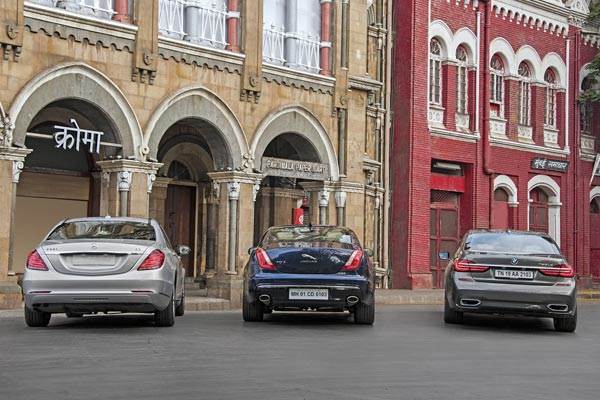
It is unbelievably close between the BMW and the Mercedes, more so than it’s ever been. The 7-series finally has the ride quality that’s as good as its razor-sharp dynamics, the cabin quality has met the benchmark if not surpassed it, and the astonishing amount of tech and gadgetry just blows the others away. The best part is that it can play the limo role when you want and, should you want to take the wheel, it’ll thrill you as well. But it really begs the question – does anyone actually do that with their long-wheelbase diesel limousine? I’m not sure they do.
No, what you want any of these cars to do is soothe you while you’re in the back seat, being driven home from a day of board meetings. They must lock the rest of the world out and keep you tranquil. The Jaguar does that well, the BMW does it even better, but the Mercedes does it best. It’s a car that’s not at all thrilling in any sense, but that’s the whole point. It bests the others in critical areas – seat comfort, ride comfort and refinement. It may not have the bleeding-edge tech of the new 7, and yes, it does its job in a decidedly old-school way, but it also does it silently, smoothly and classily, lowering your pulse rate in the process, and that’s what matters most.

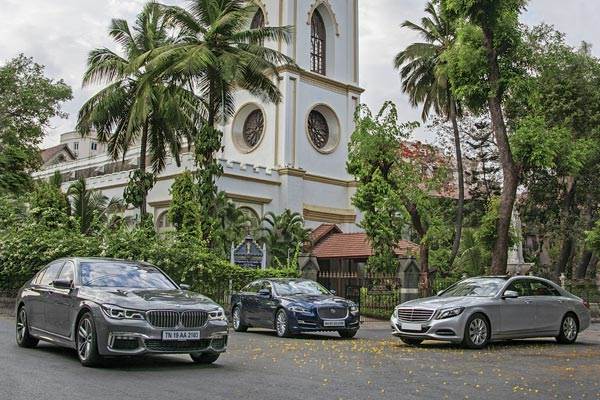
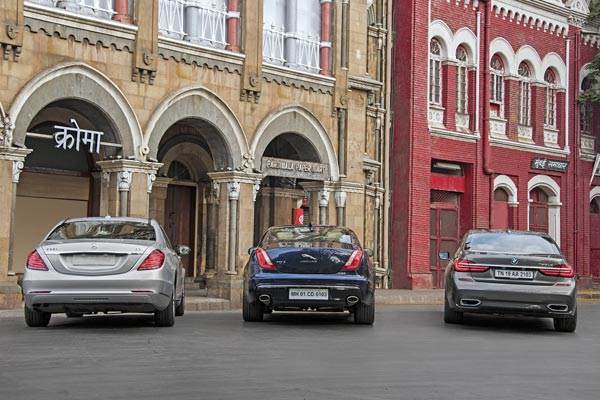
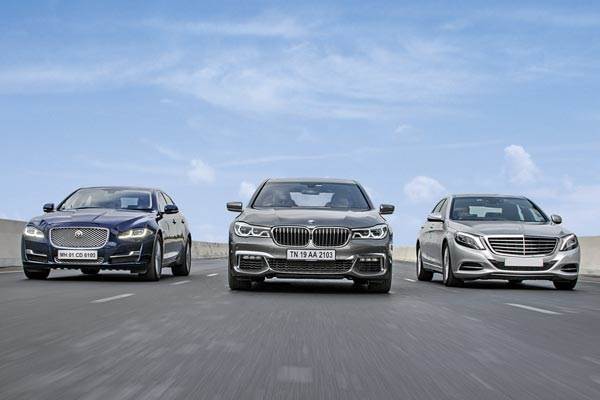
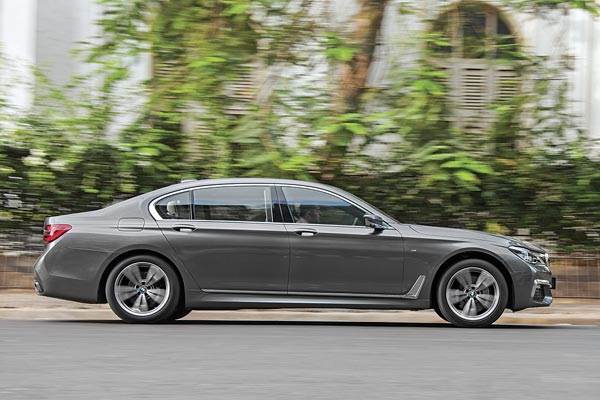


Comments
Member Login
Personal Details
No comments yet. Be the first to comment.